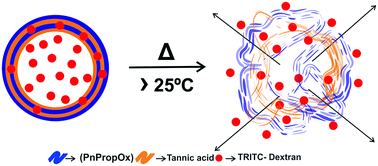当前位置:
X-MOL 学术
›
J. Mater. Chem. B
›
论文详情
Our official English website, www.x-mol.net, welcomes your
feedback! (Note: you will need to create a separate account there.)
Hydrogen bonded capsules by layer-by-layer assembly of tannic acid and poly(2-n-propyl-2-oxazoline) for encapsulation and release of macromolecules
Journal of Materials Chemistry B ( IF 6.1 ) Pub Date : 2017-10-26 00:00:00 , DOI: 10.1039/c7tb02284k Gokul Paramasivam 1, 2, 3, 4, 5 , Maarten Vergaelen 6, 7, 8, 9, 10 , Munuswamy-Ramanujam Ganesh 2, 3, 5, 11, 12 , Richard Hoogenboom 6, 7, 8, 9, 10 , Anandhakumar Sundaramurthy 1, 2, 3, 4, 5
Journal of Materials Chemistry B ( IF 6.1 ) Pub Date : 2017-10-26 00:00:00 , DOI: 10.1039/c7tb02284k Gokul Paramasivam 1, 2, 3, 4, 5 , Maarten Vergaelen 6, 7, 8, 9, 10 , Munuswamy-Ramanujam Ganesh 2, 3, 5, 11, 12 , Richard Hoogenboom 6, 7, 8, 9, 10 , Anandhakumar Sundaramurthy 1, 2, 3, 4, 5
Affiliation

|
We report hydrogen bonded capsules with the built-in ability to release loaded bioactive molecules at a physiological temperature of 37 °C. The use of neutral and non-toxic building blocks such as tannic acid (TA) and poly(2-n-propyl-2-oxazoline)s (PnPropOx) as hydrogen bonding donor and acceptor results in stable hollow capsules. The temperature induced morphological changes of the shell were investigated using a scanning electron microscope and an optical microscope and revealed pore formation in the shell when the temperature (T) increases beyond the cloud point temperature (TCP) of PnPropOx. Furthermore, confocal laser scanning microscopic investigation of the hollow capsules loaded with different probes of varying hydrodynamic diameters revealed that the open and closed state of the capsules could be effectively manipulated by varying the incubation time and hydrodynamic radius of the probes. Such hydrogen bonded capsules have high potential for use in temperature responsive sustained drug delivery applications.
中文翻译:

单宁酸和聚(2-正丙基-2-恶唑啉)逐层组装的氢键胶囊,用于大分子的包封和释放
我们报告氢键胶囊具有在37°C的生理温度下释放负载的生物活性分子的内置能力。使用中性和无毒的结构单元,例如鞣酸(TA)和聚(2- n-丙基-2-恶唑啉)(PnPropOx)作为氢键供体和受体,可以得到稳定的空心胶囊。用扫描电子显微镜和光学显微镜研究了温度引起的壳的形态变化,发现当温度(T)升高到浊点温度(T CP)以上时,壳中形成了孔。)。此外,对装有不同流体动力学直径的不同探针的空心胶囊的共聚焦激光扫描显微镜研究表明,通过改变探针的孵育时间和流体动力学半径,可以有效地操纵胶囊的打开和关闭状态。这样的氢键胶囊具有用于温度响应性持续药物递送应用中的高潜力。
更新日期:2017-11-08
中文翻译:

单宁酸和聚(2-正丙基-2-恶唑啉)逐层组装的氢键胶囊,用于大分子的包封和释放
我们报告氢键胶囊具有在37°C的生理温度下释放负载的生物活性分子的内置能力。使用中性和无毒的结构单元,例如鞣酸(TA)和聚(2- n-丙基-2-恶唑啉)(PnPropOx)作为氢键供体和受体,可以得到稳定的空心胶囊。用扫描电子显微镜和光学显微镜研究了温度引起的壳的形态变化,发现当温度(T)升高到浊点温度(T CP)以上时,壳中形成了孔。)。此外,对装有不同流体动力学直径的不同探针的空心胶囊的共聚焦激光扫描显微镜研究表明,通过改变探针的孵育时间和流体动力学半径,可以有效地操纵胶囊的打开和关闭状态。这样的氢键胶囊具有用于温度响应性持续药物递送应用中的高潜力。











































 京公网安备 11010802027423号
京公网安备 11010802027423号